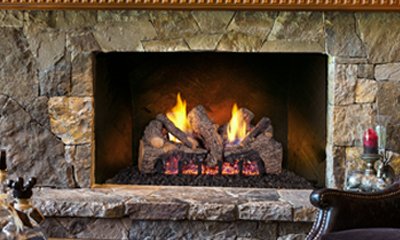Gas Fireplaces & Gas Log Sets
There are both Vented and Ventless Gas Fireplaces and Log sets. Take into consideration, the heat output and aesthetics you are desiring; as well as what you currently own. If you have a masonry chimney, you will want a log set, if there are no damages to the chimney. If you have a prefabricated fireplace. There are many options available to you, for both Natural Gas and Propane.
DIRECT VENT FIREPLACES
What Is a Direct Vent Fireplace?
Direct Vent Fireplaces are safe and efficient alternatives to traditional gas and wood burning fireplaces. These models don't require a chimney, but instead use a completely sealed venting system to operate. The system pulls fresh outside air into the firebox for combustion and exhausts combustion gases out of your home. This maintains indoor air quality and protects overall home efficiency while allowing the fireplace to work effectively.
Direct Vent fireplaces also have glass fronts and safety barrier screens. Most models come with standard tempered glass, while others offer ceramic glass as an upgrade.
Where Can You Install a Direct Vent Fireplace?
With the correct venting system, you can install your Direct Vent fireplace in practically any room of the house. They have the ability to be vented through the roof as well as through the wall having a termination cap mount on the exterior wall.
How Do B-Vent Fireplaces Work?
B-Vent fireplaces feature an open-front design and operate similarly to wood burning fireplaces. They pull fresh air into the firebox from inside your home for combustion and use a vertical pipe to carry away exhaust and fumes.
Most of the heat produced by the fire will escape through the vents. That's why B-Vent fireplaces are often used for aesthetic purposes, rather than as a supplemental source of heat.
B-Vent fireplaces create a natural movement of air through insulated pipes. The airspace between the inner and outer pipe provides insulation to prevent heat loss, while the inner pipe warms up quickly. Once the pipe is warm, hot flue gases can exit through of the top of the pipe with ease.
Where Can You Install a B-Vent Fireplace?
B-Vent fireplace installation is slightly more limited than Direct Vent or Ventless gas fireplaces.
Like a masonry chimney, the venting for B-Vent fireplaces must terminate vertically through the roof of your house. This limits the location of installation to areas where a vertical pipe can run straight up to the roof.
VENTLESS FIREPLACES
What Is a Ventless Fireplace?
Ventless, or Vent-Free, gas fireplaces are freestanding units that don’t require a chimney or venting system.
Without a chimney for hot air to escape through, all the heat produced stays inside your home. This makes Ventless fireplaces extremely efficient and economical heating sources.
While the heat output is great, the overall look of the flame display is less intense than Direct Vent and B-Vent units. For this reason, Ventless fireplaces are primarily sold as heaters, rather than decorative appliances.
Ventless Linear Fireplace as pictured:
Gas Log Sets
If you have a masonry fireplace, or specific prefab units, you can have gas log sets put into your fireplace. Gas logs are more convenient than a wood fire, because they light quick and keep the flame via propane or natural gas.
There are 2 types of gas log sets, Vented and Unvented:
For Vented, the fumes have to travel up the flue and terminate outside of the home. However, most of the heat will be drawn out of the home as well, since heat rises.
Unvented gas log sets have fumes that aren’t harmful, and they are able to vent right into the home. Therefore, there is not flue or termination, so all of the heat pours into the home. The unvented system puts off a large amount of heat, so you will have different clearance recommendations as a result; such as removing your fireplace mantle, or raising it up very high.






